Wildflowers, Grasses and Other Nonwoody Plants
Media

Species Types
Scientific Name
Chenopodium album
Description
Lamb’s quarters won’t win any beauty contests for its flowers, but it merits an award for being both a common garden weed as well as a nutritious leafy green valued around the world.
Media

Species Types
Scientific Name
Cuscuta spp.
Description
Dodders are easy to identify, even though at first you might not recognize them as plants. These parasitic plants usually look like a hairlike mass of yellow or orange, leafless, wiry, vining stems wrapping around the stems of other plants.
Media
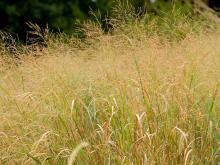
Species Types
Scientific Name
Panicum virgatum
Description
Switchgrass is a native perennial, warm-season, clump-forming mid or tall grass. In midsummer, delicate-looking, open, multiply-branching flowering clusters rise above the foliage.
Media
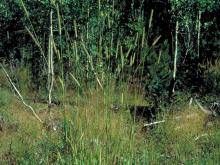
Species Types
Scientific Name
Phleum pratense
Description
A native of Europe, Timothy is a common cool-season pasture grass and occurs in a wide variety of open or disturbed habitats. It is one of the worst causes of hay fever in the late spring and early summer.
Media

Species Types
Scientific Name
Elymus virginicus
Description
Virginia wild rye can be identified by its bristly seed heads, which are held erect and whose bristle-like awns stay straight. This is a common native perennial tuft-forming, cool-season midgrass usually reaching about 2–4 feet in height.
Media
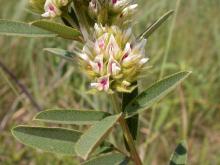
Species Types
Scientific Name
Lespedeza capitata
Description
Round-headed bush clover is a stiffly upright plant that has rounded flower clusters with cream-colored, pea-shaped flowers with purple markings on the banner petal. It grows statewide in open habitats.
Media

Species Types
Scientific Name
Xanthium strumarium
Description
Common cocklebur occurs statewide in open, disturbed, lowland habitats. It is a common weed in crop fields. It has wide, rough, coarsely toothed leaves; stout, often purple-speckled stems; and characteristic burs with hooked spines.
Media
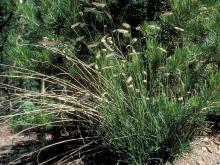
Species Types
Scientific Name
Bouteloua gracilis
Description
Blue grama is a native perennial warm-season short grass that forms dense clumps. The flowering stems are 6–12 inches tall, and the short, curving, one-sided seed head resembles an eyebrow. In Missouri, it occurs mostly in our northwestern loess hill prairies.
Media
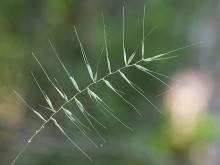
Species Types
Scientific Name
Elymus hystrix
Description
Bottlebrush grass is a native perennial, tuft-forming wild rye that typically grows in woodlands. The widely spaced spikelets spread away at a right angle from the main flowering stem.
Media

Species Types
Scientific Name
Buchloe dactyloides
Description
Buffalo grass is a native perennial warm-season short grass that creeps widely by runners and forms dense mats. As a native, it occurs in the prairies in far northwest Missouri, but it now occurs elsewhere in the state and has become popular as a lawn grass.
See Also
About Wildflowers, Grasses and Other Nonwoody Plants in Missouri
A very simple way of thinking about the green world is to divide the vascular plants into two groups: woody and nonwoody (or herbaceous). But this is an artificial division; many plant families include some species that are woody and some that are not. The diversity of nonwoody vascular plants is staggering! Think of all the ferns, grasses, sedges, lilies, peas, sunflowers, nightshades, milkweeds, mustards, mints, and mallows — weeds and wildflowers — and many more!





















